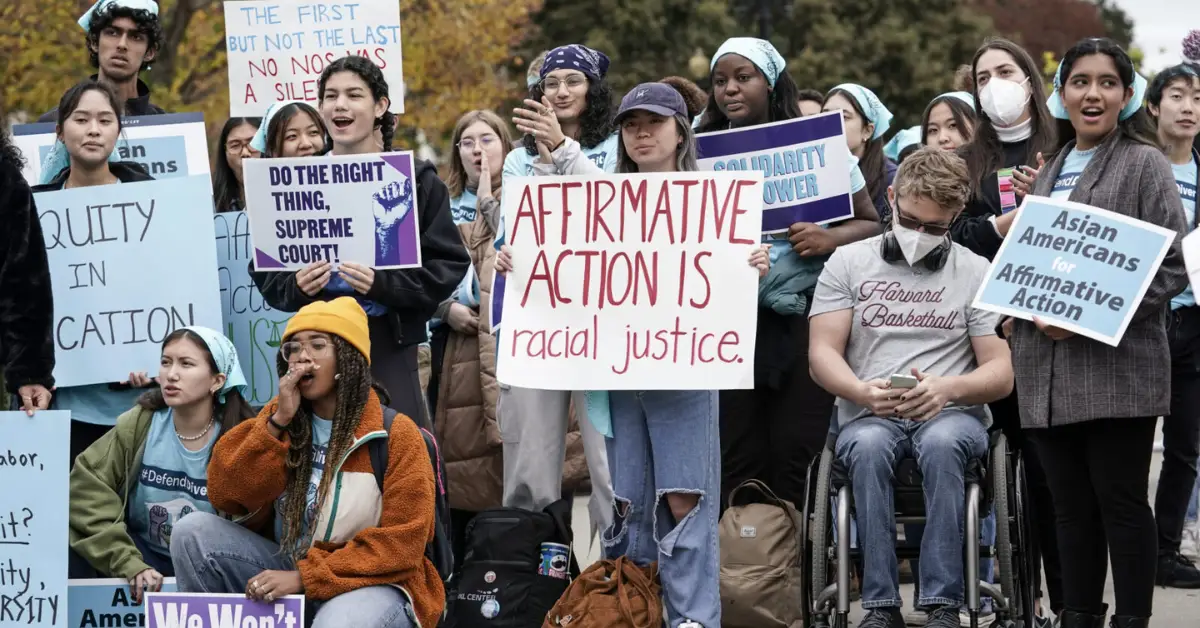The U.S. Supreme Court overturned decades of precedent on Thursday, declaring that it is unconstitutional for colleges, universities, and professional schools for law, medicine, and nursing to utilize race as one of their admissions criteria.
The decision disappoints many in the medical community, which has struggled to significantly expand the proportion of Black, Hispanic, and Indigenous physicians in recent years.
To increase the number of students from underrepresented groups and help overcome entry barriers like MCAT testing that favour students from wealthy families, several medical schools have moved to utilize race as one criterion among many in admissions choices.
In two cases, Students for Fair Admissions v. President and Fellows of Harvard and Students for Fair Admissions v. University of North Carolina, a group opposed to affirmative action sought the judges’ decisions.
The 14th Amendment’s equal protection guarantee is violated, according to the court, by the admissions procedures used by the colleges.
Chief Justice John Roberts authored the decision, with Justices Sonia Sotomayor, Ketanji Brown Jackson, and Elena Kagen dissenting and Clarence Thomas, Samuel Alito, Neil Gorsuch, Brett Kavanaugh, and Amy Coney Barrett voting in favour.
(Jackson withdrew from the Harvard lawsuit since she had previously served on the board of trustees for the university.)
The court previously stated it had “permitted race-based admissions only within the confines of narrow restrictions. University programs must comply with strict scrutiny, they may never use race as a stereotype or negative, and — at some point — they must end.”
“Because Harvard and UNC’s admissions programs lack sufficiently focused and measurable objectives warranting the use of race, unavoidably employ race in a negative manner, involve racial stereotyping, and lack meaningful end points, those admissions programs cannot be reconciled with the guarantees of the Equal Protection Clause,” the judgment stated.
However, the court’s ruling did not go so far as to forbid any discussion of race in admissions; for instance, if applicants wish to write about how their racial identity has influenced them, the court appears to agree.
“At the same time, nothing prohibits universities from considering an applicant’s discussion of how race affected the applicant’s life, so long as that discussion is concretely tied to a quality of character or unique ability that the particular applicant can contribute to the university. Many universities have for too long wrongly concluded that the touchstone of an individual’s identity is not challenges bested, skills built, or lessons learned, but the color of their skin. This Nation’s constitutional history does not tolerate that choice,” the judgment stated.
The conclusion of the argument was as follows: “nothing in this opinion should be construed as prohibiting universities from considering an applicant’s discussion of how race affected his or her life, be it through discrimination, inspiration, or otherwise. But, despite the dissent’s assertion to the contrary, universities may not simply establish through application essays or other means the regime we hold unlawful today.”
According to Students for Fair Admissions, affirmative action is “unfair, unnecessary, and unconstitutional”, and a student’s race shouldn’t either aid or hinder their chances of getting into college.
But many medical authorities assert that to develop a diverse physician workforce—which several studies have proven results in better patient care—considering race in admissions is essential.
According to dissenting opinions, the court disregards 45 years of precedent and advancement. By further entrenching racial inequity in education, the fundamental cornerstone of our democratic governance and pluralistic society, the decision “subverts the constitutional guarantee of equal protection,” according to Sotomayor.
“With let-them-eat-cake obliviousness, today, the majority pulls the ripcord and announces ‘colorblindness for all’ by legal fiat. But deeming race irrelevant in law does not make it so in life,” Jackson wrote. “Ultimately, ignoring race just makes it matter more.”
“Efforts to do away with affirmative action undermine decades of progress in creating a diverse physician workforce and will reverse gains made in the battle against health disparities,” Before the verdict was announced, Jesse M. Ehrenfeld, president of the American Medical Association, made a statement.
Wall Street Silver shared a tweet about the same news on its Twitter account:
🚨🚨BREAKING: The Supreme Court just ruled that race-based affirmative action programs are unconstitutional 🤨
Hopefully this leads to more merit based decisions, especially in critical areas like medical schools. pic.twitter.com/KOY7SsAcjq
— Wall Street Silver (@WallStreetSilv) June 29, 2023
“We cannot back down from efforts to boost the growing representation of talented and highly qualified medical students from historically marginalized groups.”
Lee Jones, dean of medical school at the Georgetown University School of Medicine, stated that Black residents in Washington, D.C., live more than 15 years less than white residents and that the ruling will hurt attempts to reduce the country’s enormous racial and health inequities.
In a recently released video series exploring what the court’s decision may mean for medicine, he said, “There is an incredibly well-documented body of literature that shows that the best, and indeed perhaps the only way, to give outstanding care to our marginalized communities is to have physicians that look like them, come from their backgrounds, and understand exactly what is going on with them.”
The price could be high. The number of Black and Hispanic students enrolling in colleges and medical institutions in California, where race was outlawed from admissions choices in 1992, fell sharply and did not rise again for decades.
No Black student in the class entered the University of California, San Diego’s medical school in 1997.
According to an amicus brief submitted in the case by the president and chancellors of the University of California, “despite nearly two decades of effort and experimentation with race-neutral admissions at UC, the university’s enrollment of underrepresented minority students falls short of reflecting the rich diversity of California’s population.”
Earlier court rulings have supported the practice of affirmative action. In the 2016 Fisher v. University of Texas judgment, the court determined that the 14th Amendment’s equal protection clause applied to the UT’s race-conscious admissions practices, making them legal.
The two new cases were brought on behalf of Asian American students, who claim that affirmative action policies harm their chances of admission, in contrast, earlier cases against affirmative action focused on white students who claimed they had not been treated fairly in the admissions process.
An Asian American teenager who was angry after being turned down by six prestigious universities despite having a near-perfect SAT score and a strong GPA was the subject of one news article that went viral this week.
(Many refuted his assertion that it was irrelevant; UC Berkeley, one of the colleges that rejected the applicant, does not even consider SAT scores, while the other prestigious institutions cited frequently reject applicants with perfect SAT scores.)
Despite making up just 7% of the population, more than 20% of graduates from medical schools are Asian, and 6% are Black, despite making up more than 13% of the population.
Indigenous physicians are one of the most underrepresented groups.
Siobhan Wescott, the Susan and Susette La Flesche Professor of American Indian Health at the University of Nebraska Medical Center, noted that the percentage of American Indian and Alaska Native physicians in the physician workforce is far lower than their representation in the general population of the United States, which is 3%.
“Imagine how much more marginalized we might become without affirmative action if Native physicians make up less than one percentage point of the physician workforce with affirmative action in place.”
According to polls, 69% of Asian Americans support affirmative action, and at least one research found that when race is taken into account when making admissions decisions at highly elite universities, Asian Americans are likely to benefit, not lose.
According to a May study, 63% of Americans believe colleges should consider race when making admissions decisions, but it should not be the primary factor.
While most Americans felt affirmative action should continue, 70% of respondents to a recent CBS poll with somewhat different phrasing disagreed, saying it shouldn’t be a factor in college admissions.
In a recent op-ed, scholar Janelle Wong and author Viet Thanh Nguyen argued that the SAT itself is a poor indicator of merit because it heavily favours those with high incomes and highly educated parents.
They claimed that the statistic that Asian Americans need to score 140 points higher on the SAT than others to gain college admission had been thoroughly debunked.
Furthermore, they contended that contrasting Asian American students with other students draws attention away from the more significant issue of a college and medical school admissions process that privileges the advantaged.
These are some posts related to news that are similar to this one, You can find related articles to this post below:
- The Controversial Role Of Scot Peterson In The Parkland School Shooting: Justice Or Jail?
- Charlotte Prep’s Resilient Rebuilding Efforts After Lower School Fire
- How Many School Shootings Have There Been This Year After Nashville in 2023?
It has “been weaponized to delegitimize critiques of the U.S. as a white supremacist and anti-Black society,” Eujin Park, an assistant professor at Stanford’s Graduate School of Education, wrote in an analysis earlier this week.
Eujin Park cited the use of Asian Americans as examples of how hard work leads to success in America and that no assistance like affirmative action is required.
The Association of American Medical Colleges and 14 other organizations dedicated to advancing healthcare education filed an amicus brief with the Supreme Court earlier this summer, vehemently supporting affirmative action for medical schools as a vital national healthcare requirement.
“Diversity literally saves lives by ensuring that the Nation’s increasingly diverse population will be served by healthcare professionals competent to meet its needs, as an overwhelming body of scientific research compiled over decades confirms,” they wrote.
Medical schools will probably now need to use different tactics, including class-based admittance or an emphasis on students from underprivileged areas, to continue to diversify their student body.
Despite the long-standing affirmative action ban in California, this strategy has been successful at UC Davis, which graduates classes of new doctors that are remarkably diverse.
However, this success came only after more than a decade of painstaking work to completely rethink how admissions are conducted and how students from diverse backgrounds are supported.
Tyler is a passionate journalist with a keen eye for detail and a deep love for uncovering the truth. With years of experience covering a wide range of topics, Tyler has a proven track record of delivering insightful and thought-provoking articles to readers everywhere. Whether it’s breaking news, in-depth investigations, or behind-the-scenes looks at the world of politics and entertainment, Tyler has a unique ability to bring a story to life and make it relevant to audiences everywhere. When he’s not writing, you can find Tyler exploring new cultures, trying new foods, and soaking up the beauty of the world around him.











